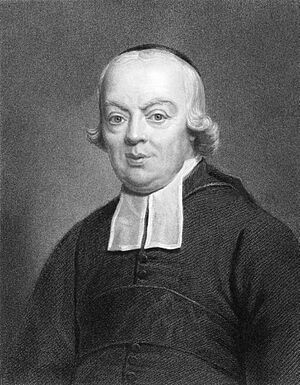Charles-Michel de l'Épée facts for kids
Quick facts for kids
Abbé
Charles-Michel de l'Épée
|
|
|---|---|

Founder of the first public school for the deaf
|
|
| Born | 24 November 1712 Versailles, Yvelines, France
|
| Died | 23 December 1789 (aged 77) Paris, France
|
| Alma mater | Collège des Quatre Nations, University of Paris |
Charles-Michel de l'Épée was an important French educator from the 1700s. He is known as the "Father of the Deaf" because of his work helping deaf people. He was born on November 24, 1712, and died on December 23, 1789. He was a kind person who dedicated his life to helping others.
Contents
Who Was Charles-Michel de l'Épée?
Charles-Michel de l'Épée grew up in a rich family in Versailles, France. Versailles was a very important city at the time, the center of the French kingdom. He first studied to become a Catholic priest.
L'Épée later decided to help poor people. One day, while visiting a poor area of Paris, he met two young deaf sisters. They communicated using their own sign language. This meeting inspired L'Épée to dedicate his life to educating deaf people.
In 1760, he opened a school. He believed that deaf people could learn and understand language. He also thought they should be able to take part in religious ceremonies. In the early 1760s, his school became the world's first free public school for the deaf. It was called the Institut National de Jeunes Sourds de Paris.
L'Épée's main goal was religious education. However, his work also helped deaf people in other ways. He developed a system of "Signed French". This allowed deaf people to legally defend themselves in court for the first time.
L'Épée's Legacy and Impact
L'Épée died in 1789, at the start of the French Revolution. His tomb is in the Church of Saint Roch in Paris. Just two years after his death, the French government recognized him as a "Benefactor of Humanity." They also declared that deaf people had rights, just like everyone else.
In 1791, the school L'Épée founded began to receive money from the government. His teaching methods spread around the world. Today, L'Épée is seen as one of the most important people in the history of deaf education. After L'Épée's death, Roch-Ambroise Cucurron Sicard took over as the head of the school.
The Method of Signs (signes méthodiques)
L'Épée's teaching method was called the "Instructional Method of Signs." It focused on using gestures or hand signs. He believed that deaf people learned best through their eyes, just as hearing people learn through their ears.
He knew that deaf people in Paris already had their own sign language. However, he thought it was too simple. He encouraged his hearing teachers to learn these signs. But in the classroom, he used his own system. This system combined some existing signs with new signs he invented. His goal was to represent all the parts of the French language, like verb endings and prepositions.
L'Épée's system was sometimes called "Methodical Signs." It was an early form of what we now call Manually Coded Languages. These are systems that try to show spoken language using signs. However, L'Épée's system was often difficult and unnatural for deaf signers to use.
A deaf student and later teacher at the school, Laurent Clerc, said that deaf people never used these "methodical signs" outside of class. They preferred to use their own community language, which is now known as French Sign Language.
How L'Épée Changed Education
What made L'Épée special was that he shared his teaching methods with everyone. He allowed other educators to visit his classrooms and learn from him. Because of his openness, his methods became very influential. They still impact deaf education today.
L'Épée also started training programs for teachers from other countries. These teachers then took his methods back to their own nations. They helped set up many deaf schools around the world. For example, Laurent Clerc, a deaf student from L'Épée's school, helped start the first school for the deaf in North America. He brought with him the sign language that became the basis for modern American Sign Language (ASL). This included the signs for the ASL alphabet.
Some deaf schools in Germany and the UK at the time used a different approach. They focused on teaching deaf students to speak and lip reading. This was called the oralism method. L'Épée, however, believed in the manualism method, which used signs. These other schools kept their methods secret and saw L'Épée as a competitor. The debate between oralism and manualism still exists today. Oralism is sometimes called the German method, and manualism the French method, because of these early differences.
The Paris school that L'Épée founded still exists today. It is now called the Institut National de Jeunes Sourds de Paris. It uses French Sign Language in class, not L'Épée's old methodical signs. It is one of four national deaf schools in France.
Common Misunderstandings
Many people still think that L'Épée invented sign language or taught deaf people how to sign. This is not true. In fact, deaf people taught him how to sign! L'Épée simply organized and wrote down French signs. He did this so they could be taught to others, especially for religious education.
Tributes to L'Épée
On November 24, 2018, Google Doodle honored Charles-Michel de l'Épée on what would have been his 306th birthday.
Images for kids



